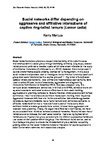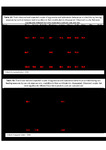Social networks differ depending on aggressive and affiliative interactions of captive ring-tailed lemurs (Lemur catta)
| dc.contributor.author | Marcus, K. | |
| dc.date.accessioned | 2020-10-10T18:41:12Z | |
| dc.date.available | 2020-10-10T18:41:12Z | |
| dc.date.issued | 2020 | |
| dc.identifier.citation |
Marcus, K. (2020) ‘Social networks differ depending on aggressive and affiliative interactions of captive ring-tailed lemurs (Lemur catta)’, The Plymouth Student Scientist, 13(1), p. 64-96. | en_US |
| dc.identifier.uri | http://hdl.handle.net/10026.1/16506 | |
| dc.description.abstract |
Social network analysis provides a deeper understanding of the dynamic social relationships within a social group through identifying centrality, subgroups, isolated individuals and preferred or avoided dyads which have shown effective for the study of dominance hierarchies (Funkhouser et al., 2018). However, this is rarely used in captive environments despite showing promise for its management. In this study, social network analysis was used to investigate the dominance hierarchy, dyadic and group-level social relationships in a captive group of 11 ring-tailed lemurs (Lemur catta) at Bristol Zoo Gardens. Focal-animal and instantaneous scan sampling were used to collect 90 total hours of associative, aggressive and allogrooming interactions from October to November 2018. Data was analysed using R to compute social networks and centralities. In Minitab and SPSS, correlations and chi-squared tests were conducted to detect differences in male scent marking, aggressive and grooming behaviours. Results matched previous studies with female dominance, linear hierarchies and dominant males scent marking more frequently. Aggression increased with food and individuals exhibited few extreme aggressive behaviours. Agonistic networks had a higher variability of centralities compared to affiliative networks which had a more even distribution of interactions. More dominant individuals were generally more central, initiated more aggression and received more grooming. Finally, the bigger the difference in dominance, the more cautious subordinate individual behaved across all networks. Results indicate that all individuals act to increase their own social benefits. They also highlighted which individuals are important for group cohesion and the different approaches individuals use based on their position within the group. The information found can be used to help manage this group to ensure the improvement of group welfare, supporting growing evidence that social network analysis is invaluable for captive applications aided further when combined with classic data analysis. | en_US |
| dc.language.iso | en | en_US |
| dc.publisher | University of Plymouth | en_US |
| dc.rights | Attribution 3.0 United States | * |
| dc.rights.uri | http://creativecommons.org/licenses/by/3.0/us/ | * |
| dc.subject | Social networks | en_US |
| dc.subject | affiliative interactions | en_US |
| dc.subject | captive ring-tailed lemurs | en_US |
| dc.subject | Lemur catta | en_US |
| dc.subject | xtreme aggressive behaviour | en_US |
| dc.subject | allogrooming interactions | en_US |
| dc.title | Social networks differ depending on aggressive and affiliative interactions of captive ring-tailed lemurs (Lemur catta) | en_US |
| dc.type | Article | en_US |
| plymouth.issue | 1 | |
| plymouth.volume | 13 | |
| plymouth.journal | The Plymouth Student Scientist |




